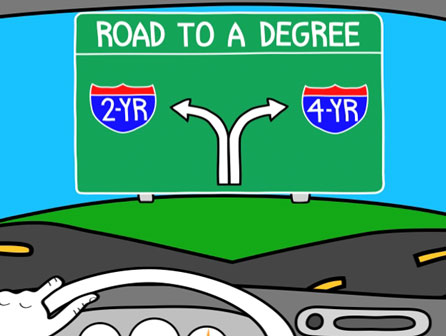Senior year is so exciting. Everyone talks about prom, the senior trip, and of course graduation day. Students have been told forever that one day, they will go to college. Now faced with acceptances and big decisions, they may encounter an important decision they didn’t prepare for: “What type of college should I attend?” Understanding the key differences between a four-year college and a community college is essential for making a major life choice.
A four-year college typically offers a bachelor’s degree and provides a more comprehensive education. In contrast, a community college offers two-year programs that lead to an associate’s degree. According to Community College vs College: 8 Key Differences by UoPeople, “Community colleges typically offer two-year associate degrees, which can either lead directly to employment or set a foundation for further study. Colleges usually offer four-year bachelor’s degrees, providing a greater variety of majors that can lead to advanced studies or diverse career options.” Similarly, Community College vs. a Four-Year University: 8 Key Differences by Going Merry states, “At community colleges, undergraduate students work toward an associate’s degree, which is typically awarded after two years or sixty credits of study. Similar to four-year schools, you can find associate’s degrees focused on any number of topics, from culinary arts to business.” These sources highlight that the type of degree earned depends on the institution: community colleges award associate’s degrees, while four-year colleges award bachelor’s degrees. Students can also transfer from a community college to a four-year college to complete a bachelor’s degree.
Some four-year colleges even offer the opportunity to pursue a bachelor’s and a master’s degree simultaneously. According to Going Merry, “At a four-year school, undergraduates work toward a bachelor’s degree. The time to complete these degrees can vary between three to six (or even more) years. However long it takes, a student earns 120 credit hours and completes their degree requirements. You can earn a bachelor’s degree in any number of fields. At some four-year universities, students can even work toward a bachelor’s degree and a master’s degree simultaneously.” This shows that four-year colleges can provide more advanced academic opportunities.
Class sizes also differ between the two types of institutions. Community colleges generally have smaller class sizes, which allows for more personalized instruction and easier access to faculty. According to UoPeople, “Community colleges usually have smaller class sizes, which allows for more personalized instruction and easier access to faculty. Four-year colleges may have larger classes, especially in introductory courses, and often focus more on research.” This suggests that community colleges may offer a more supportive learning environment while four-year colleges may emphasize academic research and larger-scale instruction.
Cost is another major factor. Community colleges are significantly more affordable than four-year colleges. UoPeople notes, “Community colleges are generally more affordable, often making them an attractive option for students concerned with educational expenses. Four-year colleges, with additional resources and facilities, tend to charge higher tuition fees.” Going Merry adds, “With an average cost of $1,865 per semester, community college is almost one-third of the price of a traditional four-year school. At an in-state, public university (which tends to be the most cost-effective of all four-year options), one semester will run you $4,839.” These figures show that community colleges are a more budget-friendly option for many students.
Finally, admission requirements vary. Community colleges typically have open admission policies, requiring only a high school diploma. In contrast, four-year colleges often have selective admissions based on academic performance, standardized test scores, and other criteria. As UoPeople explains, “Community colleges typically have open admission policies, making higher education accessible to a broader audience. In contrast, four-year colleges often have selective admissions based on academic performance, standardized test scores, and other factors.”
Both four-year colleges and community colleges offer valuable educational opportunities, but they differ in terms of cost, degree offerings, class size, and admissions requirements. Community colleges are more affordable, have smaller class sizes, and are accessible to a wider range of students. Four-year colleges offer more advanced degrees and a broader academic experience.Understanding these differences can help students choose the path that best fits their goals and circumstances.


























